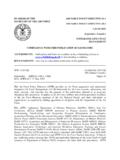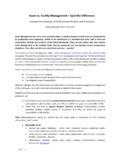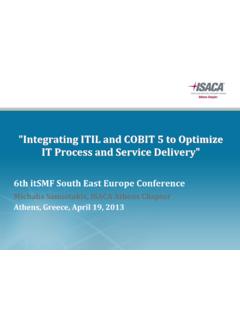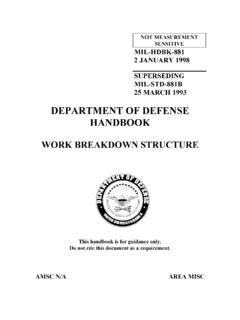Transcription of L Funds — Lifecycle Funds - TSPFundTrading.com
1 Thrift Savings Plan5/08 Thrift Savings PlanL Fu n d sLifecycle FundsFund InformationAs of December 31, 2007 Net Assets $ billion2007 Administrative Expenses $ per $1,000 account balance, .015% ( basis points)Investment Objective FundGrowthPreservation of AssetsL 2040 HighVery LowL 2030 HighLowL 2020 Moderate/HighLowL 2010 ModerateModerateL IncomeLowHighTime Horizons(when you expect to need the money)Choose: If your time horizon is:L 2040 2035 or laterL 2030 2025 through 2034L 2020 2015 through 2024L 2010 2008 through 2014L Income Today and the near future InceptionAugust 1, 2005 Key FeaturesThe L Funds diversify participant accounts among the G, F, C, S, and I Funds , using professionally determined investment mixes (allocations) that are tailored to different time horizons.
2 The L Funds are rebalanced to their target allocations each business day. The investment mix of each fund adjusts quarterly to more conservative investments as the fund s time horizon shortens. The objective of the L Funds is to provide the highest possible rate of return for the amount of risk in the L Funds is not a guarantee against loss and does not eliminate risk. The L Funds are subject to the risks inherent in the un-derlying Funds , and can have periods of gain and loss. The L Funds returns will be approximately equal to the weighted aver- age of the G, F, C, S, and I Funds returns.
3 Earnings are calculated daily, and there is a daily share price for each L 204017%10%24%41%8%L 203019%20%15%9 %37%L 202031%8%32%11%18%L 201058%7%19%10%6%L Income74%6%12%5%3%SCFGIGICFCSGFSIGFCFCSG ISA llocation Targetsas of January 1, 2008 IPage 2 TSPLF14LL Funds and the Efficient Frontier(At Inception)L Fu n d Fa c t sThe L Funds are intended to meet the investment needs of TSP participants with time horizons that fall into five different date ranges, as shown on the front. The five L Funds were designed for the TSP by Mercer Investment Consulting, Inc.
4 The asset allocations are based on Mercer s assumptions regarding future investment returns, inflation, economic growth, and interest rates. The TSP will review these as-sumptions at least annually and determine whether changes to the allocations are 2040, L 2030, L 2020, and L 2010 are for participants with time horizons that fall within the defined date ranges. The asset allocations of these Funds are adjusted quarterly, moving to a more conservative mix, gradually approaching that of the L Income fund . Between quar-terly adjustments, the asset allocation of each fund is maintained through daily rebalancing to that fund s target allocation.
5 When a fund reaches its horizon, it will roll into the L Income fund , and a new fund will be added with a more distant time horizon. For example, in 2010, the L 2010 fund will roll into the L Income fund , and a new L 2050 fund will be created. The L Income fund is designed to produce current income for participants who are already receiving money from their accounts through monthly payments and for participants who plan to withdraw or to begin withdrawing from their accounts in the near future. The asset allocation of the L Income fund does not change over time; it is maintained through daily rebalancing.
6 The pie charts on the front show the 1/1/08 allocations of the L Income, L 2010, L 2020, L 2030, and L 2040 Funds in each of the five under-lying TSP Funds . The allocation to the G fund , which has the least amount of risk, is largest in the L Income fund , and becomes succes-sively smaller with the more distant target dates. In contrast, the allocations to the F, C, S, and I Funds , which carry varying degrees of risk, but also the potential for higher returns, are largest in L 2040 and smallest in the L Income fund . The graph below depicts the expected return and risk associated with each of the five L Funds at inception.
7 The expected returns are de-rived from Mercer s economic assumptions and are not guaranteed. Expected variability of the investment returns is a measure of risk in investing. For each risk level, there is one optimal asset allocation that provides the highest expected return. The collection of optimal asset allocations make up the Efficient Frontier, which is shown by the curve. Asset allocations that are below the Efficient Frontier are less than optimal, because there is an asset allocation along the frontier that provides a higher return for the same level of risk, or lower risk for the actual returns received.
8 The five TSP L Funds have initial asset allocations that correspond to points shown on the Efficient Frontier. Putting your entire TSP account into one of the L Funds allows you to achieve the best expected return for the amount of expected risk that is appropri-ate for your time time, the L Funds (except for the Income fund ) will roll down the Efficient Frontier. That means that, as their allocations are ad-justed each quarter, the Funds shift left on the line, becoming less risky, until they eventually merge into the L Income fund . The administrative expenses associated with the L Funds are those of the underlying G, F, C, S, and I Funds , calculated in propor-tion to their allocations in each L fund .
9 The L Funds do not have any additional charges. There are no restrictions on investing in the L Funds . You may invest any part of your TSP account in any L fund , and even invest in more than one L fund . But it is recommended that you put your entire TSP ac-count into just one L fund the one with the target date that is closest to your time horizon. Any other strategy may result in an asset allocation that is less than optimal ( , not on the Efficient Frontier), or which is not suited to your investment time , however, that risk and expected return are based on assumptions about future economic conditions and investment perfor-mance.
10 There is no guaranteed rate of return for any period, either short-term or long-term. Note: Participants interfund transfer (IF T) requests redistribute their existing account balances among the TSP Funds . For each calendar month, the first two IF Ts can redistribute money among any or all of the TSP Funds . After that, for the remainder of the month, IF Ts can only move money into the G fund . (For participants with both civilian and uniformed services accounts, this rule applies to each account separately.)G fund F fund C fund S fund I fund Expected ReturnRisk (Standard Deviation)






